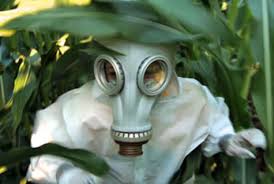Toxic chemicals are affecting aquatic ecosystems even at surprisingly low concentrations, study finds
11/15/2018 / By Russel Davis

Toxic chemicals — such as fungicides and antidepressants — entering waterways and aquatic ecosystems may cause adverse behavioral changes in aquatic animals even at relatively low levels, a study published in the Environmental Pollution journal has revealed.
According to experts, fungicides used on staple crops such as rice, oats, wheat, and potatoes are found in great concentrations in waterways in Europe, Asia, Australia, and South America. The scientists have also noted that traces of antidepressants are detected in urbanized rivers across the world. Antidepressants are also known to enter both freshwater and marine environments, the scientists added.
As part of the study, a team of researchers at the University of Barcelona in Spain and the University of Portsmouth in the U.K. examined the effects of both toxic chemicals on amphipods or shrimp-like creatures in a laboratory setting. The research team observed that the creatures swam faster when exposed to either fungicides or antidepressants, but moved more sluggishly when exposed to both toxins.
The scientists have also noted that while the creatures preferred eating leaf littler in the riverbeds, the presence of fungicide in the water made the food source less palatable for the animals. In addition, the research team observed that traces of antidepressants in the water made the animals eat less. The experts have also noted that these changes in feeding and swimming behaviors were detrimental to the animals’ growth, reproduction, and survival, which in turn may impacted the food chain.

“Most of the world’s urban waterways receive a cocktail of pollutants from agricultural run-off to human sewage containing sometimes high concentrations of medicines like antidepressants. Such cocktails may stop short of killing marine species, but we are concerned at what sub-lethal effects certain pollutants maybe having. There can be thousands of different chemicals in our rivers and seas, from agricultural run-off to sewage effluent, and though they stop short of being lethal, these contaminants can damage the health of aquatic ecosystems,” study co-author Professor Alex Ford told Science Daily online.
“These findings underline the importance of understanding and knowing the impact of complex mixtures of pollutants are having. One of the great conundrums for environmental toxicologists is how can we possibly determine or predict the effects of every combination of chemicals when there are simply thousands released into the environment, many of which have had quite limited toxicity assessment,” Professor Ford added.
Antidepressants are also found in the Great Lakes region’s fishes
A study conducted by researchers at The State University of New York at Buffalo has revealed that traces of antidepressants have been seen in the brains of certain fish species commonly found in the Great Lakes region. The researchers examined 10 fish species including several types of bass, perch, walleye, and bowfin to carry out the study.
The research team observed that rock bass samples had the highest concentrations of norsertraline at 400 nanograms per gram of brain tissue. Norsertraline is the active ingredient in Zoloft. The experts also discovered that the same fish species exhibited relatively high concentrations of citalopram and norfluoxetine According to the scientists, citalopram is the active ingredient in Celexa while norfluoxetine is a metabolite of the active ingredient in Prozac and Sarafem. (Related: Great Lakes fish found heavily contaminated with antidepressant drug chemicals.)
The results also showed that sertraline levels found in the tissue samples of smallmouth bass, largemouth bass, and rock bass as well as white bass and walleye were about 20 or more times higher than levels observed in river water. More than 50 percent of the fish brain samples showed norsertraline levels of 100 nanograms per gram or higher, the experts added.
“These active ingredients from antidepressants, which are coming out from wastewater treatment plants, are accumulating in fish brains. It is a threat to biodiversity, and we should be very concerned,” lead researcher Diana Aga has stated in university release.
Sources include:
Submit a correction >>
Tagged Under:
This article may contain statements that reflect the opinion of the author





















